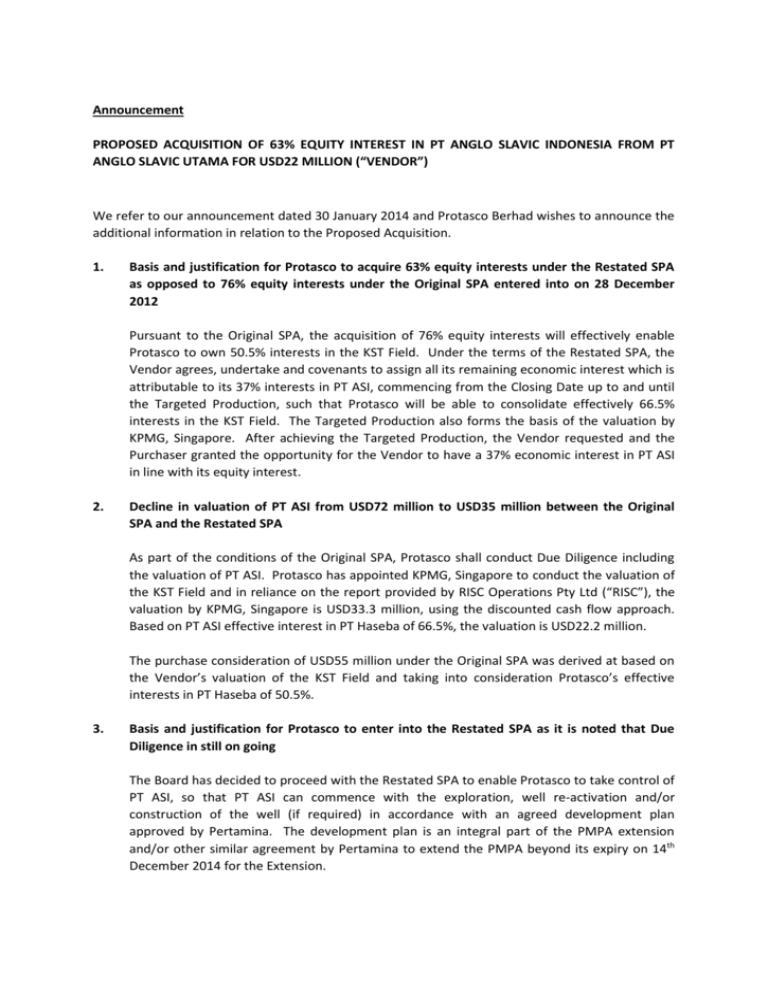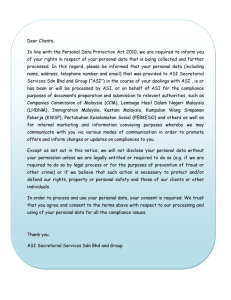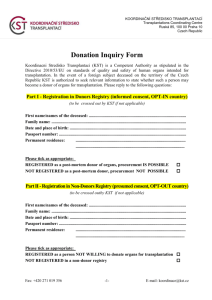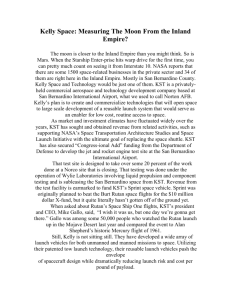PRTASCO_100214 - Protasco Berhad
advertisement

Announcement PROPOSED ACQUISITION OF 63% EQUITY INTEREST IN PT ANGLO SLAVIC INDONESIA FROM PT ANGLO SLAVIC UTAMA FOR USD22 MILLION (“VENDOR”) We refer to our announcement dated 30 January 2014 and Protasco Berhad wishes to announce the additional information in relation to the Proposed Acquisition. 1. Basis and justification for Protasco to acquire 63% equity interests under the Restated SPA as opposed to 76% equity interests under the Original SPA entered into on 28 December 2012 Pursuant to the Original SPA, the acquisition of 76% equity interests will effectively enable Protasco to own 50.5% interests in the KST Field. Under the terms of the Restated SPA, the Vendor agrees, undertake and covenants to assign all its remaining economic interest which is attributable to its 37% interests in PT ASI, commencing from the Closing Date up to and until the Targeted Production, such that Protasco will be able to consolidate effectively 66.5% interests in the KST Field. The Targeted Production also forms the basis of the valuation by KPMG, Singapore. After achieving the Targeted Production, the Vendor requested and the Purchaser granted the opportunity for the Vendor to have a 37% economic interest in PT ASI in line with its equity interest. 2. Decline in valuation of PT ASI from USD72 million to USD35 million between the Original SPA and the Restated SPA As part of the conditions of the Original SPA, Protasco shall conduct Due Diligence including the valuation of PT ASI. Protasco has appointed KPMG, Singapore to conduct the valuation of the KST Field and in reliance on the report provided by RISC Operations Pty Ltd (“RISC”), the valuation by KPMG, Singapore is USD33.3 million, using the discounted cash flow approach. Based on PT ASI effective interest in PT Haseba of 66.5%, the valuation is USD22.2 million. The purchase consideration of USD55 million under the Original SPA was derived at based on the Vendor’s valuation of the KST Field and taking into consideration Protasco’s effective interests in PT Haseba of 50.5%. 3. Basis and justification for Protasco to enter into the Restated SPA as it is noted that Due Diligence in still on going The Board has decided to proceed with the Restated SPA to enable Protasco to take control of PT ASI, so that PT ASI can commence with the exploration, well re-activation and/or construction of the well (if required) in accordance with an agreed development plan approved by Pertamina. The development plan is an integral part of the PMPA extension and/or other similar agreement by Pertamina to extend the PMPA beyond its expiry on 14th December 2014 for the Extension. Notwithstanding the above, the Vendor are required to resolve all outstanding matters in the Due Diligence within 6 months to the satisfaction of Protasco, and Protasco has the right to terminate the Restated SPA. Upon termination of the Restated SPA, the Purchase Price shall be refunded in full by the Vendor, or Protasco shall be entitled to deal with the Secured Shares. 4. Rationale for preparing the 5 months FPE 30 May 2013 for PT ASI The financial year end for PT ASI and the Target Group Companies is 31 December. The 5 months FPE 30 May 2013 was prepared to facilitate the Due Diligence. 5. To provide commentary on the Loss After Tax (“LAT”) incurred for 2012 and 2013 The LAT for FYE 31 December 2012 was mainly due to administrative expenses incurred. For FYE 30 May 2013, the LAT increased due to interest expense incurred on borrowings. 6. 7. To provide breakdown and composition of the Net Assets (“NA”) 30.5.2013 RM 31.12.2012 RM Current Assets Non-current Assets 17,795,505 18,254,653 36,050,158 31,621,095 121,920 31,743,015 Less: Liabilities 4,888,336 --------------31,161,822 --------------- --------------31,743,015 --------------- To disclose basis and justification (including bases and assumption) in arriving at the valuation of USD35 million. The NA as at 31 May 2013 is RM31,396,878 (approximately USD9 million) The NA of PT ASI was not taken into consideration in arriving at the Purchase Consideration in the Restated SPA. The NA is retained in PT ASI and Protasco will share the proportionate NA in PT ASI based on its shareholdings in PT ASI. The valuation of USD33.3 million in KST Field by KPMG, Singapore is arrived at using the income approach [discounted cash flow method (“DCF”)]. In arriving at the valuation, the following bases and assumptions are used: (a) (b) There is no current Profit Sharing Scheme (“PSC”) in place and the valuation assumes the contract term based on PSC, assumed to start from 15th December 2014 The production profiles for oil and gas are as provided by RISC in their report (c) (d) (e) (f) (g) (h) 8. The oil price forecast is based on Bloomberg’s composite forecast for Brent crude price as at 30 September 2013 for 2014 to 2017 period, plus a differential of USD1.00/per barrel (‘bbl”) based on the historical and forecasted price differential between Indonesia crude price and the Brent crude price, as adjusted for inflation forecast using Economic Intelligence Unit (“EIU”) US inflation forecast for 2014 to 2017. The natural gas forecast of USD5/mcf is based on Business Monitor international (“BMI”) historical prices for natural gas in Indonesia in 2011. First Tranche Petroleum (“FTP”) allocated is assumed to be 15% of the total liftings for both oil and gas. The pre-tax split for FTP between the contractor and the government for oil is assumed at 25% and 75% respectively. For gas, the FTP split is assumed at 50% and 50% respectively between the contractor and the government Cost recovery of 85% of operating expenses is assumed in the DCF analysis The combined tax rate assumed is 40%, comprising applicable corporate tax rate of 25% and branch profit tax of 25% Real discount rate of 13% is applied taking into consideration the risk profile associated to the KST Field Signature/bonus payments to Government have not been considered as this is determined based on negotiations with the Government in the PSC. Basis and justification to adopt DCF method as opposed to other methodology The methodologies available for the valuation are: - Income approach - Market approach (including comparable companies and comparable transaction methods) - Cost approach (net asset) In selecting the appropriate methodology, the following have been considered: - Nature of the business Availability of financial data of the KST Field Available data for comparable companies and comparable transactions Current condition and future business plan of the KST Field The DCF method is applied as the primary approach and cross checked with the valuation by calculating the implied resource multiples and comparing these implied multiples with other comparable companies. The net assets approach would not reflect the value appropriately as the value of the Target Group Companies lies on the on-going operations of its business and not in the underlying assets. 9. Detailed information on PT FAS and PT Haseba Information on PT FAS PT FAS was incorporated in Indonesia on 29th July 2003 as a private limited company. PT FAS is an investment holding company. The authorised share capital of PT FAS is IDR 2,000,000,000 comprising 20,000 shares of IDR 100,000 each of which all have been issued as fully paid-up capital. PT FAS is 95% ownedsubsidiary of PT ASI. The sole director of PT FAS is Benny Tjokrosaputra. Information on PT Haseba PT Haseba was incorporated in Indonesia on 28th July 2000 as a private limited company. PT Haseba is principally involved in upstream oil and gas activities. The authorised share capital of PT Haseba is IDR 1,000,000,000 comprising 1,000 shares of IDR 1,00,000 each of which all have been issued as fully paid-up capital. PT Haseba is 70% owned-subsidiary of PT FAS. The other shareholders of PT Haseba are Insinyur Ibrahim Yahya (12.5%), Insinyur Haji Syahabuddin Abdul Rachman (10%) and Perusahaan Daerah Pembangunan Aceh (7.5%) The directors of PT Haseba are Benny Tjokrosaputra and Herman Koswara. 10. Detailed information on KST Field The KST Field is a mature oil field located onshore in Aceh in Northern Sumatra, Indonesia. It forms a low relief structure anticline which is approximately 6km long and 1.5 km wide. KST Field is covered by a broad 2D seismic grid and 30 wells have been drilled. The KST Field is part of the bigger Rantau Block, which has around 600 production wells. Production commenced in 1974 and ceased in 1996. Pertamina entered into a 10-year PMPA with PT Haseba on 14 January 2004. In 2010, PT FAS acquired 70% interests in PT Haseba and started further development on the KST Field. The PMPA was then novated by an agreement dated 3rd February 2012 by Pertamina to PT Pertamina EP (“Pertamina EP”), and was amended by a supplemental agreement between Pertamina EP and PT Haseba. The key features of the PMPA are: (a) (b) (c) (d) (e) (f) Oil and gas produced by PT Haseba from the KST Field must be delivered to Pertamina EP and compensated at a predetermined price. PT Haseba has the right to buy back the natural gas that it has produced from Pertamina EP, and this right can be transferred to PT FAS which intends to process the natural gas into compressed natural gas The PMPA is valid for 10 years starting 14th December 2004 (until 14th December 2014) PT Haseba is entitled to USD32.39/bbl for every barrel received at sales point when the Indonesia Crude Price (“ICP”) is over USD100/bbl If the ICP falls below USD100/bbl, PT Haseba’s entitlement will change according to the rates agreed in the PMPA PT Haseba bears its own operating and capital expenditures. There is no mechanism for cost recovery under the PMPA. Until the acquisition of PT Haseba by PT FAS, production relied only on natural flow with no artificial lift technology and minor production facilities. Consequently, oil production has been minimal. Historical average oil production has varies from 1,000 barrels of oil per day (“bopd”) to a peak of 8,000 bopd, while gas production has varied from 1,000 to 3,000 bopd equivalent. RISC analysis of the detailed production information shows cumulative historical oil production of at least 3.7 million barrels of oil (“MMbbl”), with most likely historical production of 5.7 MMbbl. Protasco had on 23rd May 2013 appointed RISC to undertake the feasibility study on the KST Field. RISC has classified the remaining potential of the field as contingent resources, as there are currently no approved re-development plans for the KST Field. The table below summarises the contingent resources estimates for the KST Field: P50 Oil Total production oil (MMbbl) Gas Total production Gas (billion cubic feet (“bcf”) 7.2 44.2 P50 - 50% probability that the stated quantities will be equalled or exceeded Detailed development activities have not yet been formulated as a staged re-activation of the field is envisaged. There are approximately 30 wells in the field, some of which may be able to be reactivated. The initial plan would be to re-enter selected wells to determine the condition of the wellbore. If the wells are found to be in appropriate condition a suitable downhole pump would be run in the well to determine if the well is capable of sustained production. If the activation of the wells are possible, there will be less intense capital expenditure required for new wells. If the wells are not in good condition it will be necessary to drill new wells to determine the potential of the field to sustain economic production. Seismic data will also be acquired and analysed to determine the optimum location of the new wells. It is envisaged that 1 or 2 wells would be drilled and tested initially before committing to a longer term drilling programme. The nature of that programme would be determined by the results of the seismic interpretation and production tests conducted on the wells. Simple surface facilities would also be installed to separate oil, gas and water, store the oil, dispose of the water and either dispose of gas or process and export the gas. Certain field enhancement will also be done, such as safety and security enhancement, pollution control and cleaning of the well heads. Other than the Protasco Advance, PT ASI does not expect any financing from Protasco. Future full scale production investment will come in once the new concession contract is in place. 11. Risks in relation to production/exploration operation which could materially affect Protasco and the mitigating factors to minimise such risks The Proposed Acquisition would expose the Company to inherence risks associated to the production/exploration as summarised below: Technological changes in the drilling and oil field services The drilling and oil field services are subject to technological changes. If the Company is unable to meet these technological changes, the Company may not be able to maximise its production output. Operational hazards of the oil and gas industry Risk and hazards inherent to drilling including blowouts, reservoir damage, loss of production, equipment damage, uncontrolled fires and explosions and pollution and other damages to the environment. Shortage of talented and experienced management and personnel The oil and gas industry requires experienced management and personnel. The inability to attract and retain sufficient qualified personnel could have a material adverse effect to the business. Adverse weather conditions and natural hazards The operations may be impacted by adverse weather conditions, such as tropical storm, that may compromise the ability to carry out the operations. In addition, natural hazards, such as tropical storms, tsunami and earthquakes, may destroy the operations. Although the Company would take the appropriate steps to mitigate these risks, there is no assurance that any changes to these factors considered would not have an adverse impact on Protasco. 12. Outlook of the oil and gas industry and Protasco future plan in light of the industry outlook Global Outlook Economic Intelligence Unit (“EIU”) expects global oil consumption to grow by an average of 1.5% in 2014 and 2015. The EIU expects minor increase in US, Canada and China’s oil consumption and a decline in oil consumption in Europe and Japan. The United States Energy Information Administration (“EIA”) projected that global consumption will increase to 97.0 MMbbl per day in 2020 and 115.0 MMbbl per day in 2040. The production outlook is stronger and EIU expects global oil supply to grow by an average of 2.4% in 2014 and 2015. EIA projected global oil production to reach 96.6 MMbbl per day in 2020 and 115MMbbl per day in 2040. Indonesia oil and gas industry The oil & gas sector in Indonesia features heavy state involvement State-owned company Pertamina is a major player in both upstream and downstream sector. Based on oil and gas industry report by BMI, investments of about USD26.2 billion are expected in the upstream sector in 2013. The government of Indonesia (“Government”) holds the rights to issue oil and gas exploration and production licenses. Blocks are awarded primarily on PSC basis which conform generally to the following rules: - Contract valid for a maximum of 30 years, extendable to a maximum of 20 years Validity period include both exploration and production Exploration period to last for 6 years can be lengthen up to another 4 years Licenses to be returned to the Government if firm fails to meet stated target in development after 5 years of exploration - Up to 25% of the total production to be set aside for domestic needs. Indonesia's oil consumption has been rising rapidly owing to high economic growth, a rising middle class and a fuel subsidy which artificially inflates demand. EIA report stated that Indonesia is struggling to meet its growing domestic oil consumption. Indonesia oil consumption grew at a compounded annual growth rate of 2.4% over the period 2003 to 2012, outpacing oil production which in comparison declined 2.9% year-on-year over the same period. BMI expects Indonesia proved oil reserves to decline to 3.8 bbl by 2017 and 3.6 bbl by 2022. BMI also expects Indonesia proved natural gas reserves to decline to 106 Tcf by 2017 and 104 Tcf by 2022. (Source: KPMG Report dated 20th January 2014) The planned redevelopment of the existing field seems like a good entry point for Protasco to venture into the Indonesian oil and gas industry, which is currently facing a declining supply of crude oil and natural gas. The learning from operating this oil and gas field can provide Protasco the confidence to venture into other O&G projects in Indonesia. Oil is a globally traded commodity. There is a liquid market for oil with the price varying depending on global and local factors as well as the oil specification and quality. Oil output in Indonesia has been falling, the country has not met its production targets in recent years. Against this background it is likely that activities that aim to increase production will be welcomed by the authorities. Markets for gas depend on regional factors including demand and route to market. It is understood there is strong demand for gas in Indonesia in general and in the Aceh region where the KST field is located. In general gas prices have been increasing, reflecting the strong demand for energy throughout Indonesia. An example of this is that a major international industrial company has issued a letter of intent to purchase gas in the KST field. 13 Rationale for the Company to agree to the term of payment as the norm of payment is to be made upon completion of the transaction or conditions precedents became unconditional The Board has decided to proceed with the Restated SPA to enable Protasco to take control of PT ASI, so that PT ASI can commence with the exploration, well re-activation and/or construction of the well (if required) in accordance with an agreed development plan approved by Pertamina. The development plan is an integral part of the PMPA extension and/or other similar agreement by Pertamina to extend the PMPA beyond its expiry on 14th December 2014 for the Extension. Notwithstanding the above, the Vendor are required to resolve all outstanding matters in the Due Diligence within 6 months to the satisfaction of Protasco, and Protasco has the right to terminate the Restated SPA. Upon termination of the Restated SPA, the Purchase Price shall be refunded in full by the Vendor, or Protasco shall be entitled to deal with the Secured Shares. 14. Information on PT Inovisi Infracom TBK (“PT Inovisi”) PT Inovisi was incorporated in Indonesia on 11th May 2007 as a public limited company. PT Inovisi was listed on the Stock Exchange of Indonesia on 3rd July 2009. PT Inovisi is principally an investment holding company with subsidiaries principally involved in mobile communication infrastructure services. The authorised share capital of PT Inovisi is IDR 2,000,000,000,000 comprising 20,000,000,000 shares of IDR 100 each of which 9,990,267,035 have been issued as fully paid-up capital. The directors of PT Inovisi are Jerry Djajasaputra, Ooi Kock Aun and Jan Adam Tangkilisan. None of the directors have any interests in PT Inovisi. The substantial shareholder is PT Green Pine, holding 60.2% equity interest in PT Inovisi. PT Green Pine has business relationship with the Vendor. The summary of PT Inovisi financial statements for the 3 FYE 31 December 2010, 31 December 2011 and 31 December 2012 are set out below: 2010 2011 2012 RM’million RM’million RM’million Revenue Profit before taxation Profit after taxation Total borrowings Shareholders’ funds 15. 83.9 31.6 31.9 4.1 234.7 138.2 98.3 97.0 29.7 390.7 313.7 116.9 116.0 53.0 504.2 Full details of other outstanding issues raised by the due diligence lawyers, consultants’ and technicians’ Other than the Conditions Subsequent as announced on 30th January 2014, the outstanding issues are: - Filing of Corporate Income Tax Return by PT ASI, PT FAS and PT Haseba - Filing of annual manpower periodic reports with the relevant regional office of the Ministry of manpower by PT Haseba - PT Haseba to establish proper reserves for the payment of severance and benefits of its employee - PT Haseba to enrols all its employees in the Social Security Insurance programme (Jamsostek) - Details in relation to outstanding shareholders loans - Improvement to the internal control systems 16. Opinion of the Board of Directors The Board of Directors, after considering the report by RISC and barring unforeseen circumstances, is of the opinion that the Targeted Production is achievable. 17. Basis in arriving at 66.5% interest in PT Haseba The 66.5% interest in PT Haseba is the effective interest in PT Haseba after taking into consideration 100% economic interests in PT ASI, which owns 95% interests in PT FAS, which in turn owns 70% interests in PT Haseba. 18. Source of fund for the Protasco Advance The Protasco Advance will be funded via internally generated funds. The remaining shareholders of PT ASI will not be making any proportionate advance, as the Protasco Advance is made for exploration and well-reactivation. The Protasco Advance is refunded in the event the Restated SPA is terminated. 19. Statement by Protasco Protasco, after considering the report by KPMG and barring unforeseen circumstances, is of the opinion that the Profit Guarantee is realistic. 20. Confirmation Statement Protasco confirms that the Proposed Acquisition will not result in diversification in operation to Protasco Group pursuant to paragraph 10.13 of Main Market Listing Requirements as there is no diversion of more than 25% of the net assets and contribution from the Proposed Acquisition. 21. Statement by Directors and Major Shareholders None of the directors and/or the major shareholders and/or person connected with a director or major shareholders have any interest, direct or indirect, in the Proposed Acquisition. This announcement is dated 10th February 2014.






